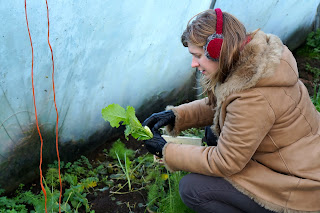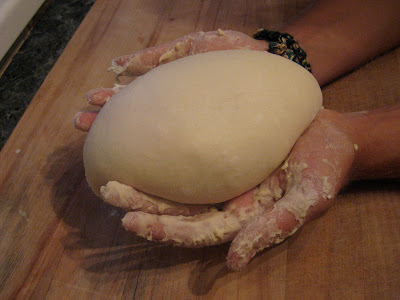AC and I were part of Root & Branch Organic's commitment to waste reduction this Thursday, as part of the European Week for Waste Reduction. We set up a stall in the Black Box in Belfast and offered organic smoothies made with 'waste products' from Helen's Bay Organic Gardens.Pretty much every food business produces waste, and even though Helen's Bay Organic Gardens compost their waste it is of course nicer when perfectly edible produce is eaten and apprecitaed by people. The smoothies were really delicious and it's such an easy thing to do with over-ripe fruit and veg. All in all the event was really fun, we had lots of delicious 'waste' food and we met many interesting people!

The big message however should really be that we all should take a moment and think how we can reduce waste, especially at home. We met two people from Belfast City Council and had a really interesting talk about waste managment. Whether you might think or not, Belfast City Council like many other councils are actually very keen for people to recycle more. Not only is it better for the environment and local waste reduction helps meet European standards, but there is also a huge difference in cost between getting rid of normal waste or recycled waste. A ton of normal waste costs the City Council about £80, whereas a ton of recycled waste only costs £8! And even your waste from brown bins comes to a cost of around £43 per ton, so still a lot cheaper. The Council thus wastes millions of pounds every year because people don't use their blue and brown bins enough, but just chuck everything into their black bins.

Of course we wouldn't be telling people how to, if we didn't do it ourselves, so we'll tell you how we reduce waste and recycle at home, and hopefully these ideas will make you think about your own waste and how to reduce it.
1) Every organic matter is pretty much composted in our house. We have two compost bins in our garden, so fresh kitchen waste from fruit and veg usually goes in there, mixed with cardboard from egg boxes and waste from the garden to create a balanced compost. And then for any cooked food waste and animal products, we use the City Council food bin, which then goes into the brown bin and then gets turned into compost as well. This is a really good second option for us because we can't put cooked food or animal products into our normal compost bins as it would attract pests and might even create harmful bacteria.
2) Paper and cardboard is either recycled by putting it into the blue bin, or because we have a wood burner we often just use it to start the fire. Anything else that can go into the blue bin also goes in.
3) For anything else that can be recycled, like glass, drink cartons etc, we're quite lucky because our recycling center is just down the road from us. We tend to just have 2-3 small boxes in our yard that we take to the recycling center every two weeks and that only really takes 20 minutes of our time. What is really important is to break the habit of just putting everything in the bin. Check what you can recycle at your local recycling center and many forms of packaging will tell you whether it's recycable or not. So now whenever we have something that can be recycled we just throw into one of our boxes, easy peasy. It really doesn't take up anymore time than just throwing it in your bin. You just have to make that initial thought and break the habit.
4) Old clothes, books, gifts and whatever else can often be given to recycling centres who then send it on to charitable organisations, or you can go straight to a charity shop of your choice and give unwanted items which other people might want. This is not only good for waste reduction but also for the charity shops who can thus make money for their charity. And don't be afraid to give torn clothes and old fabrics as these are sent on to companies who use it for compost.
5) What to do with plastic bags? Well for a start we use reusable bags so that we don't get that many plastic bags, but of course we still end up with our fair share. For the most part, we reuse plastic bags as bin bags. For us this makes perfect sense because we don't produce that much waste that goes into our normal bin and most of it is really plastic packaging, which unfortunatelly is not being recycled in many countries, even though it could be used for making bio-diesel. But plastic bags can also be used for all kinds of craft projects. Plastic actually makes for really good stuffing in handmade teddybears, pillows, you name it, as long as it's clean and dry obviously.
So this is how we reduce our waste at home, and we think that probably over 80 % of our waste is in some way or another reused, composted or recycled. The only waste we really have is loose plastics like wrappers and packaging, which could be used for better things besides landfill where it doesn't really decompose at all.
We hope that by reading this guide to waste reduction at home you might get a few ideas that change your approach to waste. As I've mentioned, most of the work is really that initial thought of how you can change your approach and then it's really just all about getting yourself organised and breaking the habit of throwing everything into the bin. It really doesn't take up that much of your time, especially whenever it becomes part of your daily routine. But of course all these suggestions should really work for you or else you can make them work according to your lifestyle. And obviously these things just take time, as it did for us, to find the perfect solution. However, we are confident that anyone can, if they want to, reduce their waste enormously. Even if it's not to the extent that we do it, it's always good to try anyway and not too feel bad about what you waste but feel good about what you save!
So let's all become a bit more conscious about what happens to our waste, which in the end is good for the environment and for us all who have to pay the taxes to get rid of the stuff!




























